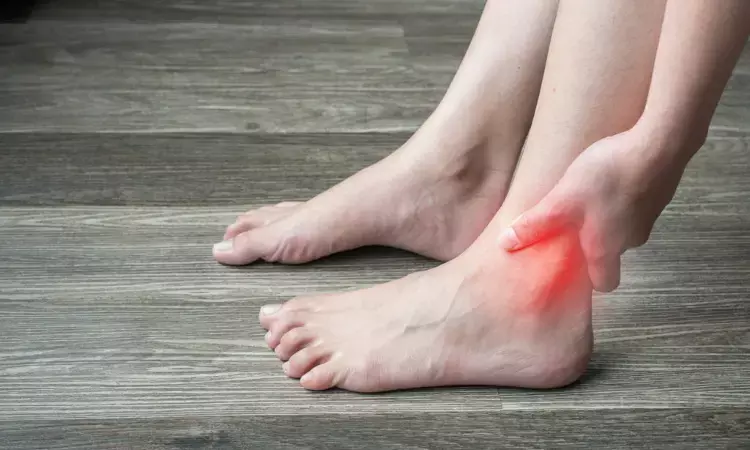- Home
- Medical news & Guidelines
- Anesthesiology
- Cardiology and CTVS
- Critical Care
- Dentistry
- Dermatology
- Diabetes and Endocrinology
- ENT
- Gastroenterology
- Medicine
- Nephrology
- Neurology
- Obstretics-Gynaecology
- Oncology
- Ophthalmology
- Orthopaedics
- Pediatrics-Neonatology
- Psychiatry
- Pulmonology
- Radiology
- Surgery
- Urology
- Laboratory Medicine
- Diet
- Nursing
- Paramedical
- Physiotherapy
- Health news
- Fact Check
- Bone Health Fact Check
- Brain Health Fact Check
- Cancer Related Fact Check
- Child Care Fact Check
- Dental and oral health fact check
- Diabetes and metabolic health fact check
- Diet and Nutrition Fact Check
- Eye and ENT Care Fact Check
- Fitness fact check
- Gut health fact check
- Heart health fact check
- Kidney health fact check
- Medical education fact check
- Men's health fact check
- Respiratory fact check
- Skin and hair care fact check
- Vaccine and Immunization fact check
- Women's health fact check
- AYUSH
- State News
- Andaman and Nicobar Islands
- Andhra Pradesh
- Arunachal Pradesh
- Assam
- Bihar
- Chandigarh
- Chattisgarh
- Dadra and Nagar Haveli
- Daman and Diu
- Delhi
- Goa
- Gujarat
- Haryana
- Himachal Pradesh
- Jammu & Kashmir
- Jharkhand
- Karnataka
- Kerala
- Ladakh
- Lakshadweep
- Madhya Pradesh
- Maharashtra
- Manipur
- Meghalaya
- Mizoram
- Nagaland
- Odisha
- Puducherry
- Punjab
- Rajasthan
- Sikkim
- Tamil Nadu
- Telangana
- Tripura
- Uttar Pradesh
- Uttrakhand
- West Bengal
- Medical Education
- Industry
PROMs & prosthesis survival in bilateral simultaneous TAA comparable with those of bilateral sequential TAA

Patients with bilateral ankle pathology represent a unique population with an overall more debilitating condition. Thus, Amanda N. Fletcher et al conducted a study to compare bilateral simultaneous and sequential TAAs, including perioperative complications and patient-reported outcome measures.
The authors performed a comparative cohort study of patients who underwent primary bilateral TAA, performed in a simultaneous or sequential fashion, at a single academic center for 12 years. Data on patient demographic characteristics, comorbidities, perioperative complications, reoperations, and implant failures were collected. Patient reported outcome measures included preoperative and postoperative visual analog scale (VAS) scores for pain, Short Form-36 Health Survey (SF-36) scores, and Short Musculoskeletal Function Assessment (SMFA) scores.
Key findings of the study were:
• A total of 50 patients (100 ankles) were included, with 25 patients (50 ankles) each in the bilateral simultaneous and sequential cohorts.
• The mean follow-up was 52.2 ± 27.3 months (range, 24 to 109 months).
• The mean time between sequential TAAs was 17.5± 20.1 months (range, 3 to 74 months).
• The mean patient age was 64.3± 10.6 years (range, 21 to 76 years), and 32 (64.0%) were men.
• The majority of patients (28 patients [56.0%]) had primary osteoarthritis.
• Both cohorts had equivalent preoperative patient-reported outcome measures and experienced improvements in all measures, which were maintained at the final follow-up with no significant between-group differences (all p > 0.05).
• There were no differences between the simultaneous TAA group and the sequential TAA group in perioperative complication rates (22.0% compared with 24.0%; p = 0.7788), reoperations (12.0% compared with 10.0%; p = 0.7354), 5-year reoperation-free survival (88.0% compared with 90.0%; p = 0.4612), or failure-free survival (100%).
• One patient in the simultaneous TAA cohort required metal component revision at 8 years postoperatively.
The authors concluded that – "The results of patients undergoing bilateral simultaneous TAA, including patient-reported outcomes, perioperative complications, and component survival, are comparable with those of patients undergoing sequential TAA. We advocate that simultaneous bilateral TAA, when performed by experienced surgeons in appropriately selected patients, is a safe and effective method for the treatment of bilateral end-stage ankle osteoarthritis. The potential benefits of simultaneous TAA warranting further investigation include decreased anesthesia events, operative time, tourniquet time, length of hospitalization, recovery and rehabilitation time, and overall cost. Future investigations will include dedicated analyses of radiographic outcomes and cost comparisons between these cohorts."
Level of Evidence: Therapeutic Level III.
Further reading:
Clinical Outcomes and Complications of Simultaneous or Sequential Bilateral Total Ankle Arthroplasty A Single-Center Comparative Cohort Study
Amanda N. Fletcher, Lindsey G. Johnson et al
J Bone Joint Surg Am. 2022;104:1712-21
http://dx.doi.org/10.2106/JBJS.22.00072
MBBS, Dip. Ortho, DNB ortho, MNAMS
Dr Supreeth D R (MBBS, Dip. Ortho, DNB ortho, MNAMS) is a practicing orthopedician with interest in medical research and publishing articles. He completed MBBS from mysore medical college, dip ortho from Trivandrum medical college and sec. DNB from Manipal Hospital, Bengaluru. He has expirence of 7years in the field of orthopedics. He has presented scientific papers & posters in various state, national and international conferences. His interest in writing articles lead the way to join medical dialogues. He can be contacted at editorial@medicaldialogues.in.
Dr Kamal Kant Kohli-MBBS, DTCD- a chest specialist with more than 30 years of practice and a flair for writing clinical articles, Dr Kamal Kant Kohli joined Medical Dialogues as a Chief Editor of Medical News. Besides writing articles, as an editor, he proofreads and verifies all the medical content published on Medical Dialogues including those coming from journals, studies,medical conferences,guidelines etc. Email: drkohli@medicaldialogues.in. Contact no. 011-43720751


